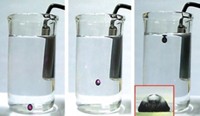Advertisement
Grab your lab coat. Let's get started
Welcome!
Welcome!
Create an account below to get 6 C&EN articles per month, receive newsletters and more - all free.
It seems this is your first time logging in online. Please enter the following information to continue.
As an ACS member you automatically get access to this site. All we need is few more details to create your reading experience.
Not you? Sign in with a different account.
Not you? Sign in with a different account.
ERROR 1
ERROR 1
ERROR 2
ERROR 2
ERROR 2
ERROR 2
ERROR 2
Password and Confirm password must match.
If you have an ACS member number, please enter it here so we can link this account to your membership. (optional)
ERROR 2
ACS values your privacy. By submitting your information, you are gaining access to C&EN and subscribing to our weekly newsletter. We use the information you provide to make your reading experience better, and we will never sell your data to third party members.
Photonics
Capillary confinement produces organized photonic films
Asymmetric drying promotes alignment of cellulose nanocrystals
by Kerri Jansen
November 18, 2018
| A version of this story appeared in
Volume 96, Issue 46

Photonic thin films—in which ordered nanostructures interact with light to produce color—can be used to make lightweight and flexible color filters, sensors, display components, and more. But ensuring that the nanocrystals within them align uniformly to produce well-defined color can be difficult and time consuming. Casting such a film in a dish, for example, can take weeks and still result in poorly controlled nanostructures and colors. Now, Georgia Institute of Technology’s Vladimir V. Tsukruk and colleagues at the Air Force Research Lab and Kent State University have developed a capillary-based method that makes highly ordered photonic thin films in a matter of hours (Nano Lett. 2018, DOI: 10.1021/acs.nanolett.8b02522). The team puts an isotropic suspension of cellulose nanocrystals in a 50-µm-thick rectangular capillary that is open on one end to allow water to evaporate. Within the confined space of the capillary, the solution dries asymmetrically and the crystals organize in a uniform pattern as the film solidifies. The film can be peeled away after breaking the capillary. The highly ordered nanostructures, which take on left-handed chirality, refract light in a predictable, uniform way. Tsukruk says his team has scaled up the technique to make films of up to 25 cm2. Mark MacLachlan at the University of British Columbia, who works with cellulose nanocrystals, says he thinks the work is an elegant contribution to the field, and it could be important for developing new microdevices, including ones that use light for biological or chemical detection.





Join the conversation
Contact the reporter
Submit a Letter to the Editor for publication
Engage with us on Twitter